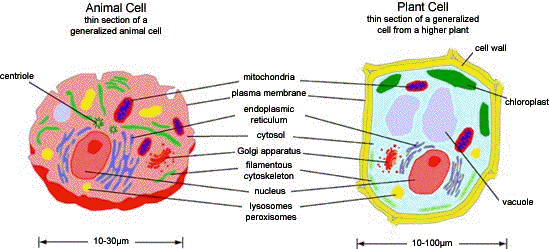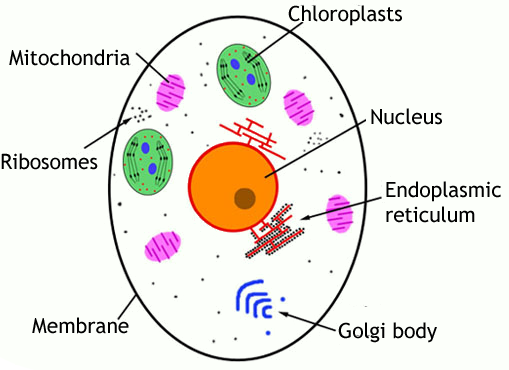Animal Cell Structure Biography
Source:- Google.com.pk
What is a cell?[edit]
The word cell comes from the Latin word "cella", meaning "small room", and it was first coined by a microscopist observing the structure of cork. The cell is the basic unit of all living things, and all organisms are composed of one or more cells. Cells are so basic and critical to the study of life, in fact, that they are often referred to as "the building blocks of life". Organisms - bacteria, amoebae and yeasts, for example - may consist of as few as one cell, while a typical human body contains about a trillion cells.
According to Cell Theory, first proposed by Schleiden and Schwann in 1839, all life consists of cells. The theory also states that all cells come from previously living cells, all vital functions (chemical reactions) of organisms are carried out inside of cells, and that cells contain necessary hereditary information to carry out necessary functions and replicate themselves. It is the basis of human life.
All cells contain:
Lipid bilayer boundary (plasma membrane)
Cytoplasm
DNA (hereditary information)
Ribosomes for protein synthesis
Eukaryotic cells also contain:
At least one nucleus
Mitochondria for cell respiration and energy
Cells may also contain:
Lysosomes
Peroxisomes
Vacuoles
Cell walls
Concepts[edit]
Plasma Membrane
Phospholipid bilayer, which contains great amount of proteins, the most important functions are the following:
It selectively isolates the content of the cell of the external atmosphere.
It regulates the interchange of substances between the cytoplasm and the environment.
Communicates with other cells.
Model of the fluid mosaic
Describes the structure of the plasma membrane, this model was developed in 1972 by cellular biologists J. Singer and L. Nicholson.
Phospholipid bilayer
Is in the plasma membrane and produces the fluid part of membranes.
Proteins
Long chains of amino acids.
Glucose proteins
Proteins together with carbohydrates in the plasma membrane, mostly in the outer parts of the cell.
Functions of proteins
Transport oxygen, they are components of hair and nails, and allow the cell interact with its environment.
Transport Proteins
Regulate the movement of soluble water molecules, through the plasma membrane. Some transport proteins called channel proteins form pores or channels in the membrane so that water soluble molecules pass.
Carrying proteins
Have union sites that can hold specific molecules.
Reception proteins
They activate cellular responses when specific molecules join.
Proteins of recognition
They work as identifiers and as place of union to the cellular surface.
Fluid
It is any substance that can move or change of form.
Concentration
Number of molecules in a determined unit of volume.
Gradient
Physical difference between two regions of space, in such a way that the molecules tend to move in response to the gradients.
Diffusion
Movement of the molecules in a fluid, from the regions of high concentration to those of low concentration.
Passive transport
Movement of substances in a membrane that doesn’t need to use energy.
Simple diffusion
Diffusion of water, gases or molecules across the membrane.
Facilitated diffusion
Diffusion of molecules across the membranes with the participation of proteins.
Osmosis
Diffusion of the water across a membrane with differential permeability.
Transport that needs energy
Movement of substances across a membrane generally in opposition to a gradient of concentration with the requirement of energy.
Active transport
Movement of small molecules using energy (ATP).
Endocytosis
Movement of big particles towards the interior of the cell using energy. The cells enclose particles or liquids.
Pinocytosis
(Literally cell drinking) Form in which the cell introduces liquids.
Phagocytosis
Way of eating of the cells. It feeds in this case of big particles or entire microorganisms.
Pseudopods
False feet (the amoeba).
Exocitosis
Movement of materials out of the cell with the use of energy. It throws waste material.
Isotonic
The cytoplasm fluid of the interior of the cells is the same that the outer.
Hypertonic solution
The solutions that have a higher concentration of dissolved particles than the cellular cytoplasm and that therefore water of the cells goes out with osmosis.
Hypotonic
The solutions with a concentration of dissolved particles lower than the cytoplasm of a cell and that therefore do that water enters the cell with osmosis.
Swelling
Pressure of the water inside the vacuole.
Endoplasmic Reticulum
It is the place of the synthesis of the cellular membrane.
Structure and function of the cell[edit]
Rudolf Virchow
Zoologist, who proposed the postulates of the cellular theory, observes that the living cells could grow and be in two places at the same time, he proposed that all the cells come from other equal cells and proposed 3 postulates:
Every living organism is formed from one or more cells
The smallest organisms are unicellular and these in turn are the functional units of the multicellular organisms.
All the cells come from preexisting cells.
Animal Cell Structure Animal Cell Model Diagram Project Parts Structure Labeled Coloring and Plant Cell Organelles Cake


Animal Cell Structure Animal Cell Model Diagram Project Parts Structure Labeled Coloring and Plant Cell Organelles Cake


Animal Cell Structure Animal Cell Model Diagram Project Parts Structure Labeled Coloring and Plant Cell Organelles Cake


Animal Cell Structure Animal Cell Model Diagram Project Parts Structure Labeled Coloring and Plant Cell Organelles Cake


Animal Cell Structure Animal Cell Model Diagram Project Parts Structure Labeled Coloring and Plant Cell Organelles Cake


Animal Cell Structure Animal Cell Model Diagram Project Parts Structure Labeled Coloring and Plant Cell Organelles Cake


Animal Cell Structure Animal Cell Model Diagram Project Parts Structure Labeled Coloring and Plant Cell Organelles Cake


Animal Cell Structure Animal Cell Model Diagram Project Parts Structure Labeled Coloring and Plant Cell Organelles Cake


Animal Cell Structure Animal Cell Model Diagram Project Parts Structure Labeled Coloring and Plant Cell Organelles Cake


Animal Cell Structure Animal Cell Model Diagram Project Parts Structure Labeled Coloring and Plant Cell Organelles Cake


Animal Cell Structure Animal Cell Model Diagram Project Parts Structure Labeled Coloring and Plant Cell Organelles Cake
No comments:
Post a Comment